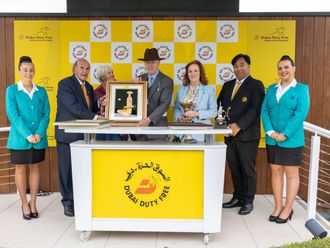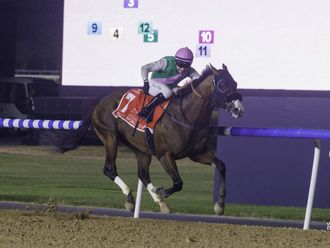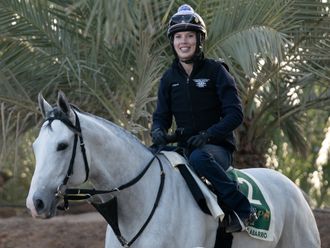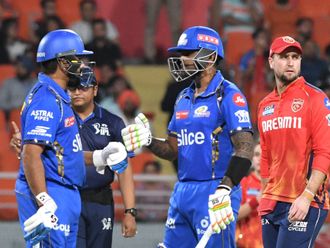Princess Haya Bint Al Hussain |
The first people to ride horses, most likely on the Arabian Peninsula and central Asia some 5,500 years ago, sparked an unstoppable global revolution.
The domestication of the horse has had a profound effect on human history. Civilisations were built on the back of working horses, whether ploughing fields, pulling loads, or carrying soldiers into battle.
The outcome of many wars hinged on the skills of these horseback warriors, who swarmed over vast swathes of the known world.
Horses meant mankind suddenly had the means to travel long distances in comparative comfort, opening up more trade opportunities and fresh horizons.
The domestication of horses drastically changed our world and played a major role in shaping our modern-day nations. No other animal has had such an influence on our geopolitical make-up.
And the speed! Horses were fleet-footed and powerful. They were a valuable status symbol for those with the means to own and care for one.
It is doubtful that human nature has changed much through the millennia. It would only have been a matter of time before two men, boastful of their mounts, would have faced off in a race to see whose horse was fastest.
Horse racing in its various forms has transcended generations and civilisations. Indeed, nearly all major civilisations through the millennia had some form of racing. It was enjoyed in Ancient Greece, Babylon, Syria, and Egypt. Most forms of racing around the world probably arose from impromptu competitions to see whose horse was quickest.
The dangerous pursuit of racing chariots — the sports cars of their era — proved hugely popular among the Greeks and Romans, as well as within the Byzantine Empire.
Horse racing grew to be an important industry in Roman times and was a major source of entertainment for the public. Mounted competitions formed part of the ancient Olympics.
Horse sports served an important double role, helping warriors practice and improve their horsemanship skills for battle.
Modern-day racing takes place in various guises. His Highness Shaikh Mohammad Bin Rashid Al Maktoum, Vice-President and Prime Minister of the UAE and Ruler of Dubai, is most passionate about two forms, endurance and flat racing.
Endurance, as its name suggests, is a contest of stamina and resilience as horse and rider cover great distances — anything up to a hundred miles.
Thoroughbred racing plays squarely to the strength of the breed — speed. In the UAE, we specialise in flat racing for Arabian and Thoroughbred horses.
The Arabian breed has been our companion since before the time of the Prophet Mohammad (Peace Be Upon Him). And there are many sayings (Hadith) in both the Muslim religion, legend, and folklore that celebrate the Arabian horse.
Modern racing, if that is the term, dates to around the 12th century, when English knights brought Arabian horses back to Britain from the Crusades. Their qualities were obvious and they were bred with English horses to improve bloodlines. Nobility wanted speed, and were prepared to wager that their horses were faster than those of their peers.
Horse racing began to evolve into a professional sport in the early 1700s, with racing contests organised on which spectators could bet on the outcome.
Prize money was offered, and breeding and owning fast horses turned into a potentially profitable enterprise.
This rise in professionalism coincided with the beginnings of the Thoroughbred breed.
The Thoroughbreds, who race today, all trace their lines to at least one of the three original desert-bred Arabian stallions imported to Britain who are considered the founding male sires of the breed. These horses, The Godolphin Arabian, The Darley Arabian, and The Byerley Turk, have left an indelible mark on the breed.
The foals born to these stallions were the first generation of Thoroughbreds.
Shaikh Mohammad named two of his global racing enterprises after two of these iconic stallions: Godolphin for racing and Darley for breeding.
Those early English racing pioneers, who pitted their horses against one another, could not have dreamed how far the sport would spread — and it has come full circle with the descendants of those original racehorses returning to the desert home of their forefathers.
By global standards, Thoroughbred horse racing in the UAE may be in its infancy, but we have come a long way. While Thoroughbred racing had its origins in the 1600s in Britain, it began in Dubai in only 1981, when Dubai’s camel track hosted the first meeting with three races.
Dubai’s first purpose-built racetrack was created in 1992, at Nad Al Sheba, and just four years later the inaugural Dubai World Cup race was held. It is now the most sought-after racing prize in the world, drawing visitors to watch the finest Thoroughbreds vie for the win.
The seven-year-old Meydan Racecourse, the world’s largest racing facility, with its grandstand stretching more than a mile, is the perfect showcase for the UAE’s racing industry and the vision of Shaikh Mohammad for racing in the region.
Shaikh Mohammad’s passion for horses is lifelong. He loves the history of racing, the challenges in achieving success, and the joy of seeing horses run. The sight of Meydan’s grandstand filling with people for the Dubai World Cup Carnival fills Shaikh Mohammad, with pride. It is an achievement that some might suggest is, to use a racing term, against the odds.
The UAE does not run the traditional Western model for racing, where a share of betting revenue is channelled back into the industry to support it. Our lack of gambling may strike many Western racing enthusiasts as unusual, but it creates such a positive dynamic for the sport.
We are left to enjoy the love of the animal, the respect and awareness of racing’s fine heritage, the professionalism of the training team, and the on-track spectacle of these magnificent horses.
— Princess Haya Bint Al Hussain is Chairman of the Board at the Dubai International Humanitarian City, Member of International Olympic Committee as UAE Representative, UN Messenger of Peace, Chairperson of Sports Accord Dubai 2010, Chairperson of UAE Nursing and Midwifery Council.












